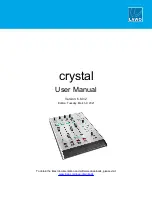
50
eDAQ Potentiostats
Using Multiple References
When using the QuadStat with a single auxiliary electrode, AE
1
, (on
QuadStat channel 1) and multiple working electrodes (WE
1
, WE
2
,
WE
3
, WE
4
) it is possible to use a separate reference electrode (RE
1
,
RE
2
, RE
3
, RE
4
) ideally placed near the corresponding WE.
This allows the potential at each of WE
1
, WE
2
, WE
3
, and WE
4
to be
accurately monitored. In the previous section, where the AE and RE
connectors were linked together, the requested applied potential is
being monitored. However when each RE is nearby to its
corresponding WE, the actual potential at each WE is being measured.
This configuration is especially recommended where the WE’s are not
equidistant to the AE and RE
1
. Remember that QuadStat channels on
which an AE is not connected will show an overload light — but in this
case there is no fault condition.
Using Multiple References and Auxiliaries
The QuadStat can also be used to conduct experiments in different
reaction vessels. In this case you should use a set of three electrodes
(working, reference, auxiliary) in each reaction vessel. Each QuadStat
channel behaves as a separate potentiostat. Independent signals can
be applied at each QuadStat channel E in connector, if desired, so that
different experiments can be run in each reaction vessel.
Please note that the use of multiple auxiliary electrodes in the same
reaction vessel will almost certainly lead to unpredictable effects and is
not recommended!
First Use
After you have installed the software, connected the
e-corder
and
computer, and connected the QuadStat as described above, you are
ready to begin.
When the
e-corder
is turned on, and Chart software started, the
QuadStat Online indicators (green),
, should
light for every channel connected.
Содержание e-corder
Страница 62: ...58 eDAQ Potentiostats ...
Страница 88: ...84 eDAQ Potentiostats ...
Страница 94: ...90 eDAQ Potentiostats ...
Страница 102: ...98 eDAQ Potentiostats ...
















































